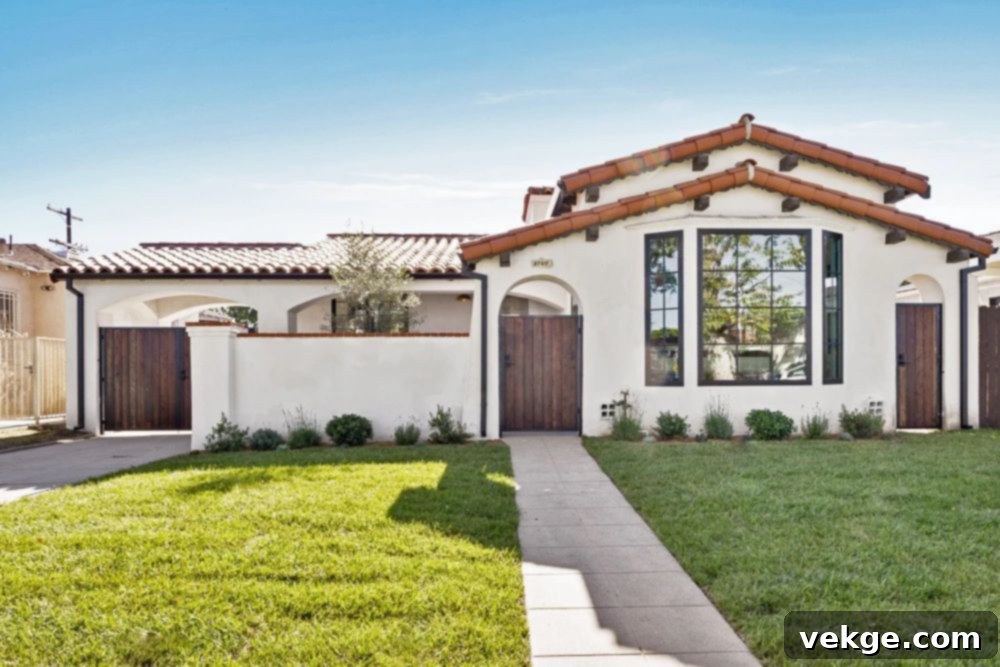Embrace Timeless Elegance: Your Guide to Spanish-Style Homes & Architecture
The enduring fascination with Spanish-style homes is a testament to the enchanting beauty and practical design elements of Spanish architecture. With roots stretching back centuries, this architectural style maintains its graceful appeal and remains highly sought after in modern home design.
Beyond their undeniable visual charm, Spanish-style homes are intelligently crafted with utilitarian features designed to provide comfort, particularly in warmer climates. Their thoughtful construction helps maintain cooler interior temperatures, making them as functional as they are beautiful.
By carefully selecting the right color palette and incorporating authentic design elements, you can create a home that exudes warmth, hospitality, and a distinct Old-World charm. In this comprehensive guide, we will delve deeper into the captivating world of Spanish-style homes, exploring their history, signature features, and how you can integrate their unique aesthetics into your own living space.
Spanish Architecture: A Legacy of Beauty and Functionality
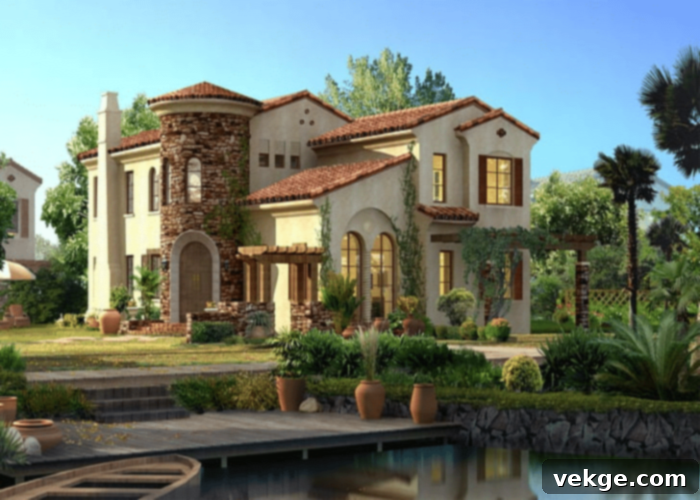
Spanish architecture has profoundly influenced global design, characterized by its intricate details, striking structures, and unique aesthetic. These homes stand apart from other architectural styles due to their distinctive features: minimal yet impactful embellishments, robust stucco and stone exteriors, and a remarkable structural uniformity that creates a harmonious look. To truly appreciate their appeal, let’s briefly trace the historical journey that shaped Spanish-style homes.
The origins of Spanish architecture are rich and diverse, heavily influenced by Moorish design from North Africa, as well as Roman, Gothic, and Renaissance styles. When the Spanish colonized the Americas, they brought these architectural traditions with them, adapting them to new climates and available materials. This fusion led to the development of various Spanish Colonial styles, particularly prominent in regions like California, Florida, and the American Southwest, where the hot, arid conditions made the functional aspects of Spanish design particularly appealing.
The enduring popularity of this style lies in its ability to combine luxurious aesthetics with practical design solutions. From grand haciendas to cozy bungalows, Spanish-style homes offer a timeless appeal that continues to inspire homeowners and architects worldwide.
The Diverse Sizes of Spanish-Style Homes
Spanish-style homes boast a wide spectrum of sizes, catering to various needs and preferences. Their versatility allows the architectural style to be adapted for everything from modest cottages to sprawling estates, offering significant flexibility in design and layout. The beauty of Spanish architecture is that its defining elements can be beautifully scaled to suit any footprint.
For those envisioning expansive living and elaborate features, large estates provide ample space to integrate a wealth of Spanish architectural details. Imagine grand courtyards perfect for entertaining, spacious living areas that flow seamlessly into outdoor patios, or multiple bedrooms designed with the characteristic comfort and elegance of Spanish luxury. These larger homes can effortlessly incorporate elements like arcaded walkways, multiple fireplaces, and extensive tilework, truly creating a palatial feel.
However, the charm of Spanish design is not exclusive to large properties. Medium-sized houses and even small cottages can be thoughtfully designed to embody the essence of Spanish architectural details. A smaller footprint might feature a cozy, intimate courtyard, a charming tiled entryway, or a living room with exposed wooden beams, all while maintaining the warm and inviting aesthetic. The key is in the thoughtful application of signature elements, ensuring that even compact spaces capture the characteristic warmth and historic appeal of the style. Regardless of size, Spanish-style homes offer a unique blend of elegance and functionality.
Key Design Elements of Spanish-Style Homes: Crafting Authenticity

The unmistakable character of Spanish-style homes is built upon a foundation of specific design elements that are both aesthetically pleasing and inherently functional:
- Stucco Exteriors and Earthy Tones: The exterior walls are predominantly finished with stucco, often painted in warm white or earthy shades. Stucco is not only cost-effective, significantly reducing construction prices compared to other materials, but it’s also highly durable and offers excellent insulation properties. Its smooth, often hand-troweled finish provides a rustic yet elegant backdrop, reflecting sunlight and helping to keep interiors cool in hot climates. While white is classic, variations in terracotta, ochre, and warm beige are also common, mimicking the natural landscape.
- Iconic Clay Tile Roofs: A hallmark feature of Spanish-style homes is their low-pitched or flat roofs topped with distinctive red clay tiles. Historically, these tiles were handmade, shaped by drying clay over cylindrical objects like logs or barrels to achieve their iconic curved form. These clay tiles are not merely decorative; they are incredibly durable, fire-resistant, and provide excellent thermal mass, helping to insulate the home from intense heat. Their warm, reddish-orange hue adds a vibrant contrast to the stucco walls and complements the natural surroundings.
- Thoughtfully Designed Windows and Courtyards: Central courtyards are a traditional and practical architectural detail in Spanish-style homes, serving as private outdoor living spaces and contributing to natural cooling through cross-ventilation. Complementing this, windows are carefully designed to manage hot summers. They are typically smaller than those in many other architectural styles, strategically placed to minimize direct sunlight penetration. Furthermore, windows are often equipped with sturdy wooden shutters, which provide additional insulation, privacy, and security while adding to the home’s rustic charm. Arched doorways and window frames are also prevalent, adding a sense of grandeur and historical authenticity.
- Subtle Ornamentation and Graceful Curves: Spanish-style homes are known for their minimal embellishments, favoring simple lines and elegant forms over excessive decoration. This characteristic restraint gives them a subtle yet unique appeal. Instead of elaborate ornamentation, the design emphasizes architectural forms like graceful curves and dramatic arches. When decorative elements are used, they are typically understated and strategically placed, often highlighting the beauty of these arches or framing the smaller windows, allowing the inherent beauty of the structure and materials to shine through.
- Wrought Iron Accents and Mediterranean Influences: To further enhance the authentic Spanish aesthetic, wrought ironwork is frequently incorporated. This can be seen in exterior details such as stair railings, balcony balustrades, window grilles, and decorative gates, adding a touch of intricate craftsmanship and security. Ironwork also extends to interior elements like lighting fixtures and fireplace screens. Furthermore, hints of Monterey style, a regional interpretation of Spanish Colonial architecture, can be integrated, often featuring a second story with an overhanging balcony, used as a functional outdoor living space. While integrating large, elaborate courtyards can sometimes be a significant investment, even smaller versions or well-designed patios can effectively mimic the traditional Spanish outdoor living experience.
Transforming Your Home with Spanish Design Elements
Modern Spanish-style homes often blend various design influences, moving beyond strictly defined elements to create unique interpretations. If you’re looking to infuse your home with the spirit of Spanish architecture, your first step is to decide on the extent of the transformation. You might choose to embrace a complete Spanish architectural theme for your entire home, or you could opt to integrate a select few key elements that capture the essence of the style. Here are some of the most impactful ways to incorporate Spanish architectural flair:
1. The Signature Clay Tile Roof: An Unmistakable Statement
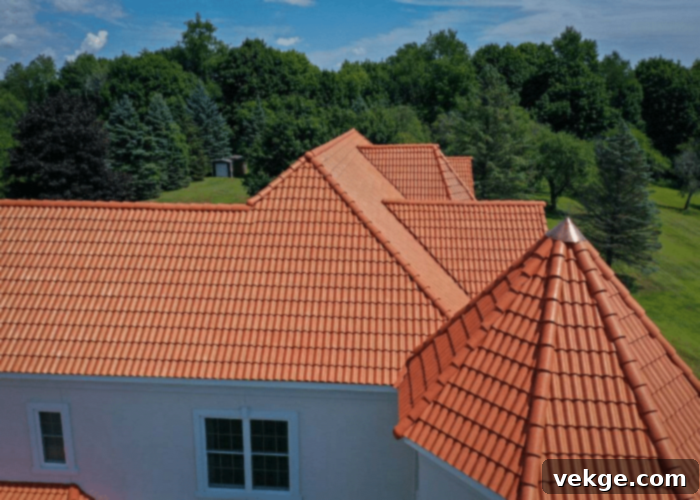
The distinct red-tiled roofs are arguably one of the most defining and visually striking features of Spanish architecture. These clay tiles gained immense popularity due to the local availability of clay materials, particularly in desert and Mediterranean climates where the style flourished. Beyond their aesthetic appeal, clay tiles offer remarkable durability, a long lifespan, and excellent insulation, reflecting solar radiation and helping to regulate indoor temperatures. While traditional barrel tiles are iconic, variations like S-shaped tiles or mission tiles can also be used to achieve an authentic look, each contributing a unique texture and shadow play to the roofline.
2. Embracing Smooth Stucco Walls: A Foundation of Warmth
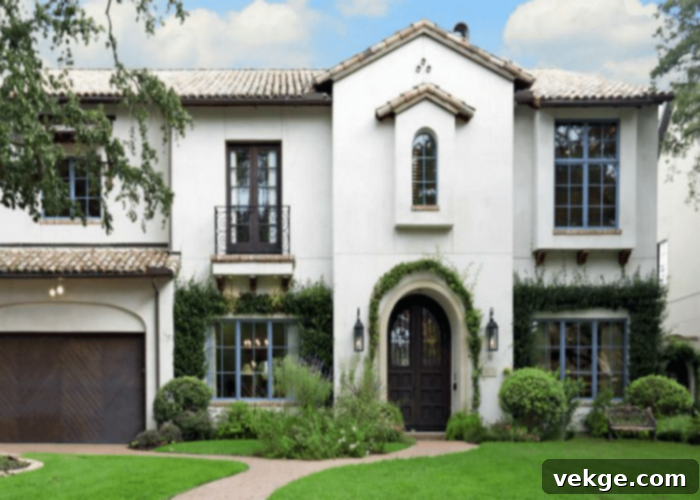
The application of stucco walls, both on the interior and exterior of your home, is perhaps the most straightforward and effective way to infuse Spanish character. Stucco provides a seamless, smooth, or subtly textured finish that is instantly recognizable. Typically painted in warm white, cream, or other earthy tones, these walls are ideal for homes in sunny regions. The functional brilliance of stucco lies in its ability to reflect sunlight rather than absorb and retain heat, thereby keeping your home cooler and more energy-efficient during hot weather. Beyond functionality, stucco creates a beautiful, minimalist backdrop that allows other Spanish elements, such as colorful tiles or dark wood, to truly stand out.
3. Integrating Ornate Wrought Iron for Railings & Stairs
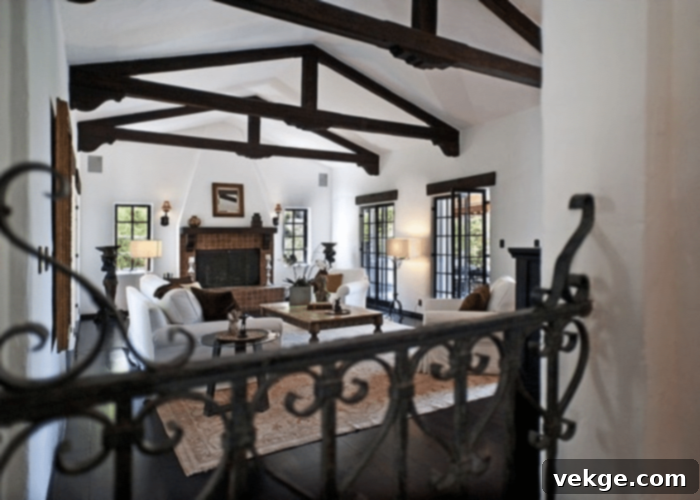
Wrought ironwork is a dominant and incredibly versatile feature in most Spanish-style homes, adding both decorative flair and structural integrity. If your home currently has wooden banisters, replacing them with intricately designed iron railings will instantly transform the aesthetic. This robust material can be incorporated throughout your property: from exterior spaces like courtyard gates, protective window grilles, and decorative staircase railings, to interior elements such as balustrades for staircases and balconies, and even decorative accents around windows. The dark, often curvilinear patterns of wrought iron create a beautiful contrast against light-colored stucco, enhancing the classic Spanish look and adding an element of sophisticated craftsmanship.
4. Highlighting Ceilings with Character and Warmth
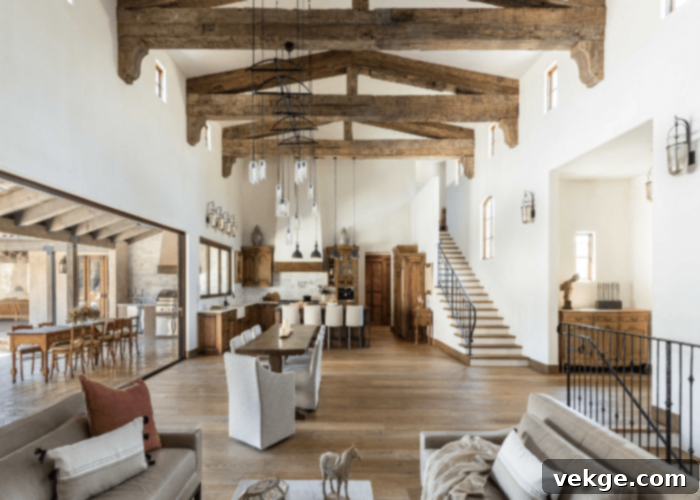
The ceilings in Spanish-style homes play a crucial role in defining the interior character. Both standard height and high ceilings can be suitable, but the key is to avoid overdoing embellishments. Spanish design favors simplicity in ceilings, often allowing the natural beauty of structural elements to take center stage. To achieve a rustic and authentic appearance, try to include exposed wooden beams. These can be dark-stained or naturally finished, running across the ceiling to create visual interest and a sense of history. To perfectly complement these wooden beams, the ceiling can be finished with simple plasterwork, and the stucco walls can be paired with minimal, sturdy wooden furniture that echoes the warmth and natural aesthetic of the beams. This harmonious approach creates an inviting and visually rich interior.
5. Flooring: The Foundation of Spanish Charm
Beyond walls and ceilings, the flooring is fundamental to capturing the Spanish aesthetic. Terracotta tiles are a classic choice, offering a warm, earthy hue and a durable, cool surface that is ideal for hot climates. These tiles can be laid in various patterns, adding texture and authenticity to any room. Alternatively, dark-stained hardwood floors or even patterned ceramic tiles, particularly in entryways and kitchens, can provide a similar warmth and rustic elegance. The goal is to choose materials that are natural, robust, and evoke the sun-drenched landscapes of Spain.
6. Incorporating Arches and Architectural Curves
Arches are a quintessential element of Spanish architecture, adding softness, grandeur, and a sense of flow between spaces. Integrating arched doorways, windows, or even decorative archways within your home can instantly evoke the style. These graceful curves break up harsh lines, create focal points, and contribute to the overall romantic and inviting atmosphere. Whether you’re building new or remodeling, incorporating subtle or pronounced arches will significantly enhance your home’s Spanish character.
These elements represent some of the most defining characteristics of Spanish homes. However, the beauty of this style lies in its adaptability, allowing you to pick and choose specific elements to create a home that truly reflects your personal taste while honoring the rich heritage of Spanish architecture.
Expert Tips for Authentic Spanish Architecture Details

To truly imbue your home with the spirit of Spanish architecture, consider these expert tips that delve into both aesthetic and functional details:
- Cultivating an Earthy Color Palette: The foundation of a Spanish-themed home lies in its color scheme. Choose an earthy color palette that immediately adds a welcoming and grounded charm. This palette should evoke natural elements: think warm red-orange hues reminiscent of terracotta, sunny yellow-golden shades reflecting the sun, deep blues like the Mediterranean sea, and various off-whites or creams for walls. These colors create a cohesive and harmonious environment, providing a sense of warmth and inviting comfort that is characteristic of the style.
- Choosing Functional and Stylish Window Treatments: Curtains in Spanish-style homes are often heavy and typically come in dark, rich colors. This choice isn’t purely aesthetic; it serves a crucial functional purpose. Heavy, dark-colored curtains are highly effective at blocking intense heat during the summer months and insulating against cold winds in winter, contributing to the home’s climate control. Beyond their practicality, these substantial draperies add a layer of luxurious texture and depth, significantly enhancing the aesthetic appeal and creating a cozy, opulent atmosphere within the home.
- Designing Serene Courtyards and Patio Arrangements: If you are planning for a truly authentic Spanish-themed home, thoughtful courtyard and patio arrangements are absolutely crucial. Courtyards and patios have been traditionally incorporated into Spanish architecture for centuries, primarily to elevate the efficient use of space, provide private outdoor living areas, and facilitate natural cooling through strategic ventilation. Design your courtyard with elements like a central fountain, potted plants, fragrant citrus trees, comfortable seating, and perhaps even an outdoor fireplace. These spaces become extensions of your living area, perfect for relaxation, dining, and entertaining, truly embodying the indoor-outdoor lifestyle.
- Incorporating Spanish-Inspired Furnishings and Decor: To complete the look, select furnishings that complement the architectural style. Opt for rustic, hand-carved wooden furniture, often with dark finishes. Include wrought iron accents in light fixtures, table bases, or decorative grilles. Hand-painted ceramics, vibrant textiles like intricately woven rugs and throws, and traditional Spanish artwork or tapestries can add splashes of color and authentic detailing, bringing the entire design together.
Conclusion: Your Dream Spanish Home Awaits
Defining a distinct style for your home is always an exciting journey of self-expression. If your heart is set on Spanish home design, you have undoubtedly chosen a style that masterfully blends timeless elegance with sophisticated functionality. It’s an architectural legacy that offers not just a house, but a warm, inviting sanctuary.
To truly capture the essence of Spanish design, ensure you incorporate its main features. Begin by focusing on core elements such as the classic stucco exteriors, the iconic red clay tile roof, and the integration of graceful arches and curves throughout the architecture. Whether you’re building a new single or two-story home, or undertaking a renovation, these key details will anchor your design firmly in the Spanish tradition.
We invite you to share your vision! Let us know in the comments which specific architectural element from Spanish-style homes you are most excited to integrate to enhance the unique elegance and charm of your own home!
